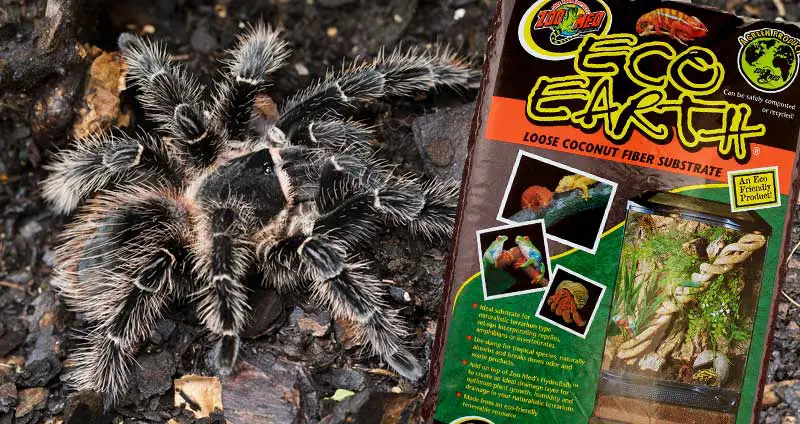The most important aspect of keeping a pet tarantula is, by far, their enclosure. As your tarantula will spend 99.99% of its time in its enclosure, it needs to be safe, comfortable, and close to their natural environment.
While the terrarium itself is extremely important, the substrate is right up there in importance. If the terrarium is the skeleton, the substrate is the muscle.
A tarantula’s substrate has quite a few benefits, and the type of substrate that you choose can have a huge impact on the well-being of your tarantula. So, you need to get it right.
This post will tell you everything that you need to know about tarantula substrate. What it is, why it’s important, and what the best tarantula substrate is.
Table of Contents
Our Top Pick
What Is Tarantula Substrate?
Tarantula substrate is the material that covers the floor of a tarantula’s enclosure. This material is often very similar in appearance and consistency to dirt.
Why write an entire post about substrate, though? Isn’t it straight forward?
Substrate isn’t just placed on the floor of the enclosure for aesthetic purposes (although it does help) — it serves quite a few different purposes that your tarantulas simply can’t do without.
In addition to all of the benefits that substrate has, many tarantulas owners will tell you different things about it. It isn’t a one-size-fits-all product that’s universally used the same.
You can use one type of substrate or mix several substrates together, pile up one inch or several inches, and mist it or keep it dry.
Fortunately, much of this isn’t opinion. It’s fact. So, after reading this post, you should understand exactly how to use tarantula substrate.
Tarantula Substrate Benefits/Uses
As stated, there are many different uses for this substrate. It helps to understand what substrate actually does so that you know how to better utilize it.
- Enhances the appearance of the enclosure – This benefit is mostly just for you, the owner. Without substrate, your tarantula would be on a bare glass/plastic floor, and this certainly doesn’t look good. Substrate gives enclosures a very natural look.
- Keeps enclosures clean – Like all living creature that eat, tarantulas poop and pee. Without substrate, this waste, along with any food remnants, will sit out and quickly smell up the enclosure. Substrate is absorbent and can do wonders with containing and masking waste.
- Provides structure – Tarantula enclosures aren’t made up of the terrarium and substrate — there’s other accessories inside that help to tie everything together. Instead of resting these materials on a bare floor, they can be set into the substrate. This helps to hold materials in place and keep the enclosure structured well. This is especially important for larger tarantulas that love to wreak havoc on their enclosure.
- Helps maintain humidity levels – When you invest in a moisture-retaining substrate, it will do wonders for maintaining an enclosure’s humidity. All tarantulas have specific humidity levels that they need to be kept at. So, when you have a substrate that can hold moisture for a long time, it will work to keep humidity levels consistently high so that you don’t have to spray the enclosure every day.
- Allows for burrowing – Nearly all terrestrial tarantulas, along with some arboreal tarantulas, have a strong desire to burrow. Tarantula substrate is an excellent burrowing medium as it’s easy to dig through and holds its structure well.
Properly Laying/Maintaining Substrate
While tarantula seems like it’s just dirt and can be laid haphazardly on the floor of the enclosure, that’s not true at all.
There’s actually a proper way to lay tarantula substrate. Or, rather, several proper ways — depending on the type of tarantula that you’re housing.
Optimal Substrate Depth
The depth of your tarantula’s substrate is actually one of the most important factors. If you have a tarantula that needs a lot of substrate but is given a little, there could be negative consequences.
What determines the depth of substrate?
It essentially boils down to your individual tarantula and whether they’re a burrowing species or not.
There are two types of tarantulas when it comes to environmental conditions: terrestrial and arboreal. Terrestrial tarantulas live on the ground, while arboreal tarantulas tend to live higher up in trees. As you may guess, most terrestrial species are burrowers.
However, some arboreal species are burrowers, too! It’s for this reason that you need to research each individual species to learn about its behaviors so that you can give it the right amount of substrate.
For burrowing species, the general consensus is to provide substrate that’s as deep as the tarantula’s legspan. So, a 5″ tarantula needs right about 5″ of substrate. This is to ensure plenty of space to burrow.
Arboreal tarantulas, on the other hand, still need substrate — just not as much. I always aim for around 2″ of substrate per arboreal enclosure unless a species prefers more depth.
Moistening The Substrate
Moistening the substrate is an important part of enclosure maintenance, too.
Keeping the substrate at an optimal amount of moisture helps to keep the enclosure humid and also provides a comfortable base for your tarantula.
Some species need humid enclosures while others need dry enclosures, and some like damp substrate while others like nearly bone-dry substrate. Once again, take the time to learn about your specific species.
There are typically two ways that owners moisten substrate. The first is by overfilling their tarantula’s water dish and letting the water saturate the substrate around the dish. Don’t get carried away here.
Secondly, you can mist the substrate with water occasionally. When misting, spray only one side of the enclosure, and avoid spraying your tarantula.
It’s recommended that you use a hygrometer to measure humidity levels accurately. With this, you’ll be able to monitor conditions and make small changes as needed.
Best Tarantula Substrates
There are a lot of substrates out there that could technically act as tarantula substrate, but many of them aren’t optimal, and some are better than others.
Below, we’ve highlighted 4 of the best tarantula substrate options and explained why they’re top picks.
Our Top Pick – Coconut Fiber
Coconut fiber substrate is easily the best tarantula substrate, encompassing nearly everything that a tarantula keeper would be looking for in a substrate.
Sold in either loose bags or compressed bricks, this soil-like material has the texture and appearance of standard soil, but it doesn’t have any of the additives that could make soil harmful.
Compressed bricks of coconut fiber substrate are very cheap to purchase, making it an effective yet inexpensive substrate option.
Many owners opt to use coconut fiber by itself, but others like to mix it with other materials to better match the needs of their tarantulas.
Pros:
- Fairly inexpensive
- Very easy to burrow into
- Absorbs and retains moisture well
- Lasts a long time without getting moldy/stale
Cons:
- Can take a while to rehydrate compressed bricks
- Can be messy
Our Runner Up – Vermiculite
Back in the earlier days of tarantula keeping, it was common to see vermiculite talked about as the best substrate, hands down. Over time, though, things have changed.
More specifically, owners have noticed that their tarantulas simply don’t find this substrate very comfortable, opting to make as little contact with it as possible.
However, the benefits of this substrate can’t be overlooked. It’s very well-liked because it retains moisture incredibly well and doesn’t mold easily.
It’s for this reason that tarantula keepers opt to mix vermiculite into their coconut fiber substrate to create the perfect blend.
Pros:
- Extremely absorbent
- Affordable
- Lightweight
- Doesn’t mold easily
Cons:
- Very uncomfortable for tarantulas
- Can’t be used alone — must be mixed into other substrate
Another Good Option – Topsoil
If you’d like to go back to simpler times, it’s absolutely possible to use standard topsoil as a tarantula substrate. Many keepers all of the world, especially keepers with large collections, use topsoil.
This material is absorbent, easy to burrow into, and extremely affordable. There are very few downsides to this material.
A big downside that should be noted, though, is that most topsoil comes with additives. This makes sense, as these additives are there to help grow whatever’s planted in the soil.
Tarantulas don’t need these additives, though, and they can pose a serious health risk. So, if you’re opting for topsoil, make sure that the soil that you’re buying has no chemical additives.
It’s also possible to use topsoil from your own backyard. If you do this, be sure to bake or freeze the soil before use to kill off any bacteria, parasites, or mites.
Pros:
- Very affordable
- Can be mixed with other substrates
- Great for burrowing
Cons:
- Inconsistent, sometimes dangerous quality
- Needs to be studied to make sure that there’s no additives
- Doesn’t absorb water as well as other substrates
Tarantula Substrates To Avoid
While there are substrates that you should buy, there’s also substrates that you should avoid.
Now, some of these substrates are simply not optimal, while others are downright harmful and may kill your tarantula. Even if they’re cheap, don’t use these substrates!
Sand
While sand can be added to other substrates to diversify it, it shouldn’t be used in anything more than very small quantities. It’s not the worst substrate that you can use, but it’s not great.
Sand doesn’t retain moisture well, burrowing into it is nearly impossible, and it’s typically unpleasant for tarantulas to be in.
It can also cover a tarantula’s prey and get ingested — something you’ll definitely want to avoid.
Gravel
Gravel is another material that tarantulas just don’t like to stand on. It can hurt their delicate feet and cause them to exhibit some strange behaviors.
Not only do tarantulas not like it, but it also doesn’t hold moisture, can trap a tarantula’s leg easily, and is very harmful in a fall.
Overall, gravel does almost nothing that a tarantula substrate is supposed to do, so it’s best that you avoid it.
Bark/Wood Chips
There are many substrates that are made from wood chips or wood shavings. These are commonly used in reptile enclosures, so it’s common for new tarantula owners to think that they’re safe for use.
Sadly, they’re very poor for use in a tarantula enclosure.
Wood chips aren’t absorbent at all, they’re very prone to mold and rot, and they can’t easily be burrowed into.
Wood chips can also splinted off and may stick your tarantula, which obviously isn’t good.
It’s not uncommon to see wood chips being sold as tarantula substrate, so be smart and look elsewhere.
Paper
Small animal cages commonly use shredded paper as substrate, and it works quite well in those cases. For tarantulas, though, this is a terrible substrate.
Paper absorbs moisture, sure, but when it absorbs the water it basically clumps up and falls apart. This is not good for a humid enclosure at all.
While very cheap (or free), shredded paper is a big no-no for tarantulas.




